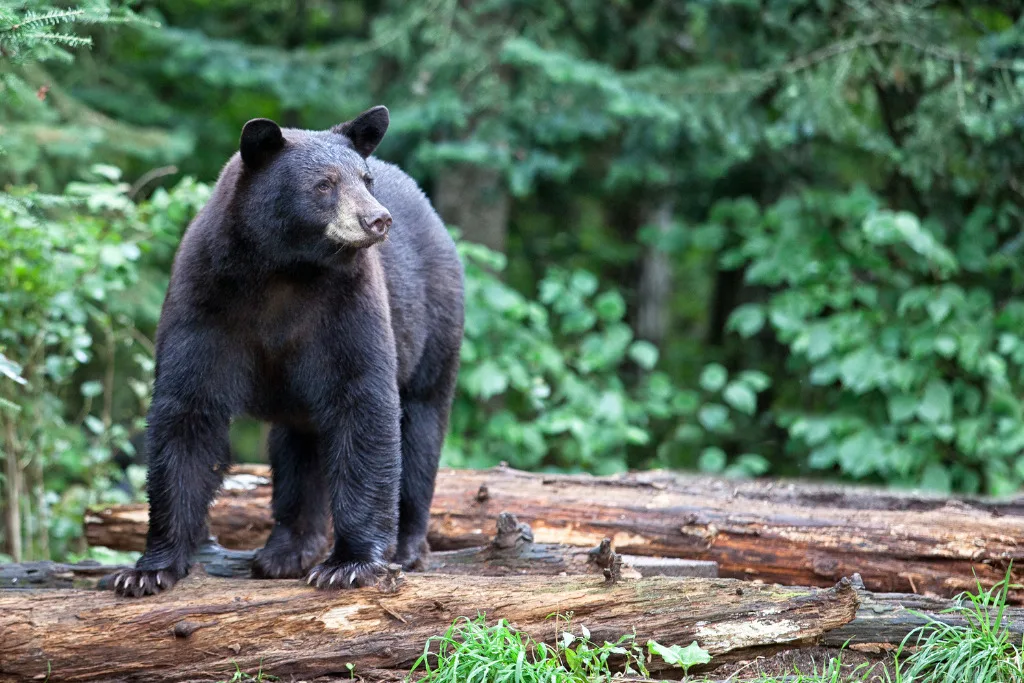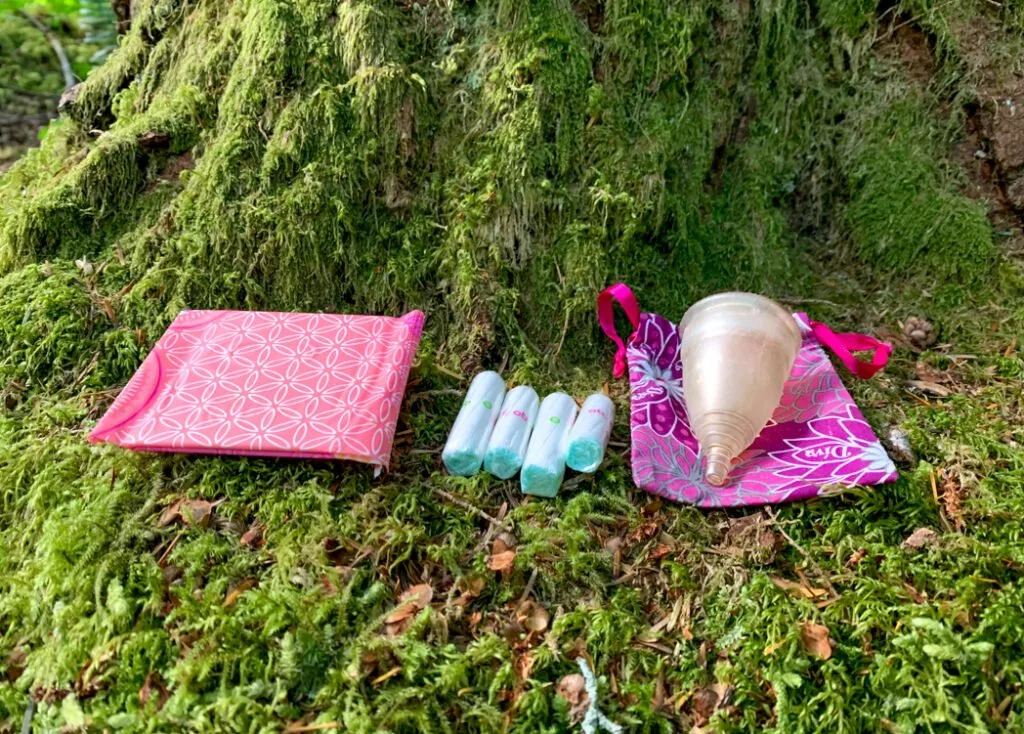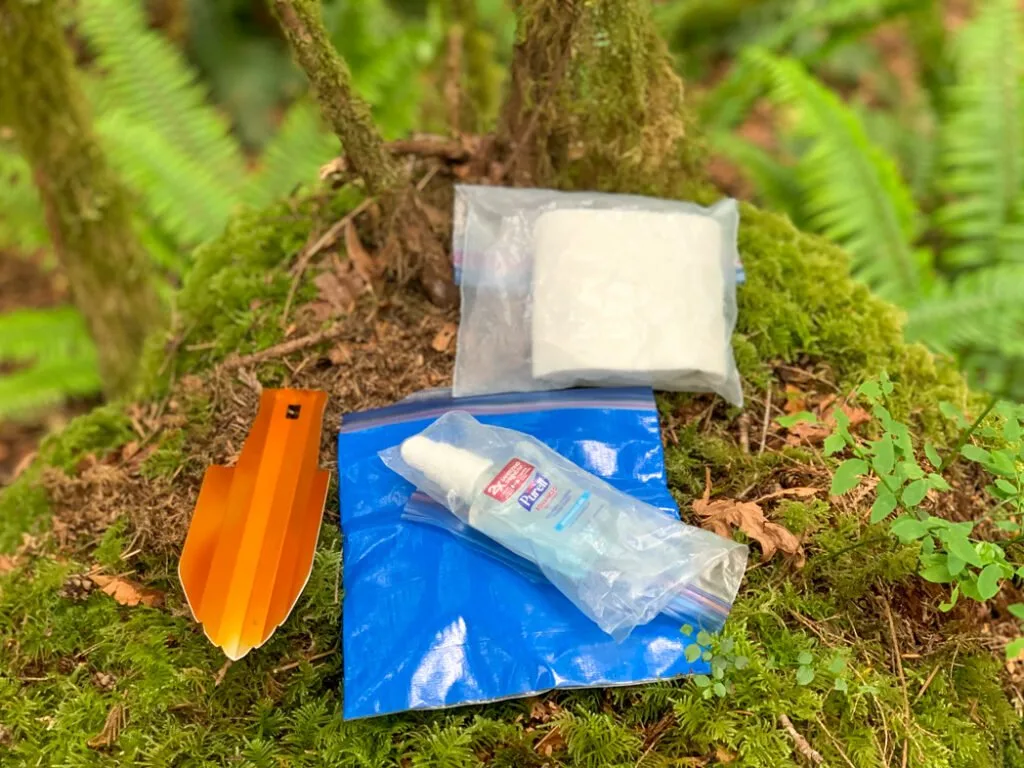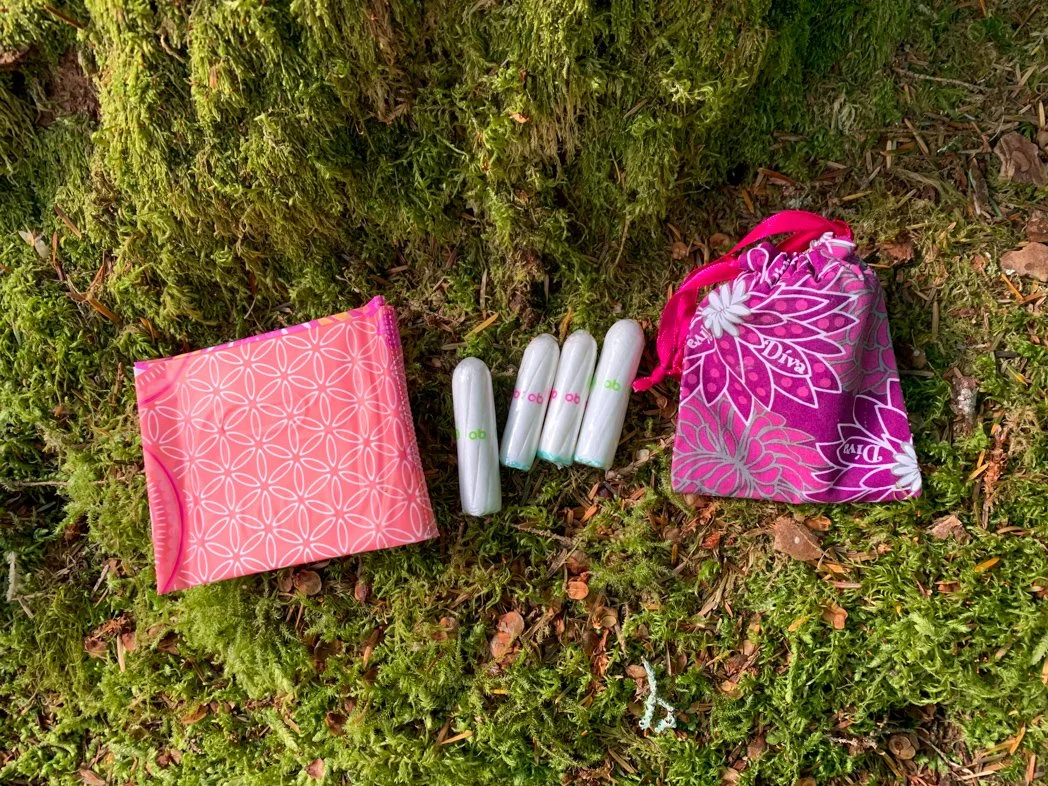Going hiking or camping while you have your period can seem a bit intimidating. Spending time away from toilets and running water is already unfamiliar for some, and adding in menstruation make it more challenging.
I’ve been hiking, camping, and backpacking with my period for over 20 years. I’m also a Leave No Trace Level 2 Instructor and the author of two backpacking guidebooks.
In this post, I’ll answer all your questions about how to camp and hike while on your period, including:
- Do you have to worry about bears when you have your period?
- Which menstrual products are best for hiking and camping?
- How can you stay clean when you have your period on a hike?
- What’s the best way to deal with cramps while hiking?
A quick note: Women and LBGTQ+ people are historically underrepresented in the outdoor community. Hesitation around hiking and camping while menstruating may one of many reasons for this. I’ve had lots of women and people who menstruate tell me they don’t feel comfortable backpacking on their period or that they are scared to try it. I hope this article gives you the info and confidence you need feel at ease hiking with your period.
Hey there: Some of the links in this post are affiliate links, which means I earn a small commission at no cost to you. Thanks for your support. -Taryn
Is it Safe to Go Hiking and Camping on Your Period?
You may have heard that it’s not safe to go hiking and camping when you have your period because you will attract bears.
Well, that’s a big fat lie – bears do NOT want to attack menstruating people!

Back in 1967, bears attacked two women in separate incidents in Montana’s Glacier National Park. Instead of blaming nearby garbage dumps and unsecured food, there was speculation that the women had been attacked because bears are attracted to menstrual odours.
Since at the time, women were not that common in the backcountry, the sexist outdoor community assumed the problem was the presence of female humans.
BUT neither of the women had their period at the time!
This misogynist myth is dangerous and keeps women and people who get periods from enjoying the wilderness.
Yes, we still need to be bear safe when we hike and camp with our periods and store our used menstrual supplies securely (more on that below). But it doesn’t make us susceptible to bear attacks.
Which Period Products Should You Use for Hiking and Camping?

These days, there are lots of period products on the market. Pads and tampons are the classic options, but you may also want to consider a menstrual cup, hormonal contraceptives, or period panties if you camp or hike on your period.
Here’s what you need to know about each option:
Pads and Tampons
If pads and tampons are your menstrual products of choice, you can definitely continue to use them camping and hiking. Before switching to a menstrual cup, I took tampons on countless hiking and backpacking trips over a 10-year span.
Here are my tips for using tampons and pads while hiking and camping:
Bring enough
Figure out how many tampons or pads you need for your trip… and then add a few more. You don’t want to run out!
Skip the applicator
Choose tampons without applicators to save space and weight. (o.b. is the most common brand, but you can also buy organic ones from smaller brands like Cora, Veeda, and Rael.)
It can take a bit to get used to going without an applicator, but it’s an easy switch. If you prefer applicators, choose cardboard ones as they are more environmentally friendly and can be squished flat to take up less room when you pack them out.
Fun fact: Tampon applicators are almost unheard of in Europe. For some reason, North American women are the only applicator lovers. Tampon applicators were actually invented in the 1920s as a way for women to avoid touching their vaginas, which was seen as immoral at the time. (Mostly because they were worried we’d like it!)
Pack it out
If you use pads or tampons, you will need to pack them out with you.
You can’t bury them in a cathole since animals will dig them up and they don’t biodegrade. You also can’t put them in the outhouse as they take decades to break down. They can also clog up outhouses and rangers may have to clean them out later. Don’t do that to the poor rangers!
Bring a sealed plastic bag to pack-out used pads, tampons, and applicators. Wrap them in toilet paper first to reduce mess.
For privacy, you can DIY a pack out bag that isn’t see-through. Try storing the ziplock inside a small stuff sack. Or cover a ziplock in duct tape or line it with a brown paper lunch bag. Toss the contents of the bag when you get home or to a garbage can.
Store it properly
Store your used menstrual supplies in your pack-out bag with your food and toiletries at night for bear safety. That means putting it in your car, a food locker, a bear canister, or a bear hang. (See my tips for bear safety for details on how to store food when backpacking and camping.)
If you’re concerned about reducing odours you can add a little bit of baking soda, coffee grounds, or an unused tea bag to your pack-out bag. Honestly, I’ve never really noticed much of an odour from my pack-out bag.
Menstrual Cup
I’ve been using a menstrual cup for the last few years and it’s been a game-changer for hiking and backpacking.
If you aren’t familiar, menstrual cups are flexible silicone cups that sit inside your vagina to collect blood. They are lightweight and reusable, so there is no waste to pack out. You can also leave it in for up to 12 hours, which I love since I only have to worry about it twice a day.
There are tons of cup brands out there. I use a Diva Cup, which is one of the most popular options. So many people are making the switch to a cup for camping and travel that MEC and REI both carry them.
Here are my tips for hiking and camping with a menstrual cup:
Practice at home first
It can take a bit of practice to get your menstrual cup inserted or removed correctly, but once you get it, it’s pretty easy. (Follow the directions that come with your cup.) I used mine at home for a few months before trying it in the backcountry.
There are tons of resources online to help you make the switch to a cup and decide which cup is right for you. I recommend Put A Cup In It, a website dedicated to menstrual advocacy and education.
Pro tip: The best way to change your cup at home is in the shower!
Empty your cup responsibly
Dispose of your cup contents the Leave No Trace way. If possible, pour it out into an outhouse. (Just be sure to keep a good grip on your cup – I live in fear of dropping mine down the hole!)
If you aren’t near an outhouse, dig a 6″ cat hole 70 big steps away from trails, campsites, and water sources. Empty your cup into the hole, then cover it up.
If you are in an area that requires you to pack out human waste, you’ll need to pack out your menstrual fluid too. Dump it in a wag bag or bring a sealed container (like a small water bottle).
Keep your cup clean
Keeping your cup clean is important for your health.
Rinse it with clean water or wipe it out with toilet paper before reinserting it. Bring the cotton bag your cup came in to store it after your period is over.
You can also buy special cup cleaning wipes. They don’t have any harsh chemicals that can damage your cup and are safe for your vagina. (Don’t use regular wipes or hand sanitizer to clean your cup as they can damage the cup and aren’t safe for your insides!)
If you are on a longer trip and want to give your cup a thorough clean, you can boil your cup for a few minutes or use biodegradable soap and warm water.
Empty your wash water into a cat hole 70 big steps from trails, campsites, and water sources. Never wash your cup directly in a stream or lake – even biodegradable soap isn’t safe for plants and fish. (Read more about washing dishes the responsible way on my guide to Leave No Trace.)
Honestly, I just rinse or wipe on the trail and save the deep cleaning for when I get home. I just make sure I keep my hands really clean whenever I’m handling my cup. (Tips on staying clean are below.)
I’ve also heard of women who have two cups. When they take the dirty one out, then put the second (clean) one in. Then they go rinse or wash the dirty one.
Hormonal Contraceptives
While you may not think of hormonal contraceptives as a way to deal with your period while hiking and camping, it’s a method that lots of people use. I’ve used this method dozens of times to avoid having my period on long backpacking trips.
If you take birth control pills, you can skip the placebo pills during the fourth week of your cycle and start the next pack of pills. That way you won’t get your period.
Some other forms of contraception can also prevent periods: hormonal IUDs, Depo-Provera injections, Nexplanon implants, NuvaRings, and contraceptive patches.
Using hormonal contraceptives to prevent your period usually works, but you may get your period anyway or experience spotting. Carry some menstrual supplies as a backup.
While skipping your period this way is generally safe, it’s a good idea to talk to your doctor about it. As well, you will run out of birth control earlier than normal, so make sure you plan for that.
Period Underwear
I have to admit that I don’t like period underwear. But I have a few friends who like them more than other menstrual products.
If you haven’t heard of them, period underwear are quick-drying underwear that have layers of absorbent and waterproof material built into the crotch – basically a built in menstrual pad.
Since they have to be washed before reusing, you will probably want multiple pairs for anything except day trips.
I think they aren’t a great option for multi-day backpacking. They might be ok for a day hike on a light flow day or as back up to tampon or cup, but otherwise, I think they aren’t worth the hassle.
They are a pain to change (you have to take off your pants and boots!) and don’t hold enough for heavy flow days. Washing them in the backcountry would take a lot of water and be very time-consuming. They also may not dry overnight so you might have to pack them up wet.
As well, used period panties need to be stored in a bear-safe way at night. That means that on backpacking trips they have to fit in your bear hang, food locker, or bear canister.
Clean Up and Hygiene Tips for Hiking With Your Period

Dealing with your period can be messy, and it gets a bit more complicated when you don’t have access to running water. But with a few supplies, it’s manageable.
Keep your hands clean
Clean hands are essential for vaginal health. You don’t want an infection or a UTI on the trail!
Wash your hands with soap and water or use hand sanitizer before and after inserting menstrual cups or tampons. (Remember to wash the Leave No Trace way with biodegradable soap away from water sources.) A water bottle with a squeeze nozzle (like a biking bottle) is helpful for washing your hands.
If you’re worried about keeping your hands clean, you can bring some nitrile gloves to use when handling your menstrual supplies. Just remember to pack them out with your trash.
Bring clean-up supplies
Be prepared for messes by bringing extra toilet paper or wipes. Skip the scented wipes that can irritate your vulva, give you a yeast infection, and attract wildlife. Unscented sensitive skin baby wipes are the cheapest option. Remember to pack them out with you as they don’t biodegrade so you can’t bury them or dump them in an outhouse.
I usually just use toilet paper and carry it in a Ziploc bag to the next outhouse or trash can, then dump it there.
Put together a period kit
Make it easy to deal with your period on the trail by storing all your menstrual supplies together in a kit.
I use a small stuff sack. Inside I have toilet paper, hand sanitizer, my pack-out bag, and my menstrual cup in its cotton bag. (I used to carry a Ziploc bag of tampons.) If you prefer to use them, don’t forget to add a small container of gentle biodegradable soap, unscented wipes, and nitrile gloves.
How to Deal with Menstrual Cramps While Camping and Hiking
Cramps are no fun at home, and they really suck on the trail. Besides just toughing it out, there are a few things you can do to deal with period cramps on the trail:
Pack your favourite pain reliever… and bring lots. You don’t want to run out!
In camp, fill a water bottle with boiling water, wrap it in a spare shirt, then use it as a hot water bottle.
Drink lots. Many women say that they find exercising when they have their period easier if they are well hydrated.
Talk to your hiking partners about what’s going on. Periods are a fact of life and not something to be ashamed of. Tell your friends if you need to slow down or take a break.
I often find that my cramps are worse when I stop moving and that I can’t hike as fast as I’d like. It’s easier if I explain that to friends at the beginning of the trip instead of silently wishing they would slow down!

Final Thoughts
So that’s everything you need to know about hiking with your period. I hope this article gives you the confidence to go ahead with a hiking or backpacking trip, even if you have your period. It’s not as scary as you might think!
READ NEXT:
- Backpacking for Beginners: Tips for Getting Started
- How to Leave No Trace (And Why it’s Important!)
- Which Women’s Specific Hiking Gear is Actually Worth Buying?
- Best Hiking Underwear For Women and Men
- 2025 Altitude Sports Black Friday Sale: My Picks for the Best Deals - November 25, 2025
- Bowron Lakes Canoe Circuit: 2026 Paddling Guide - November 20, 2025
- 2026 BC Backpacking Reservation Dates You Need to Know - November 20, 2025


H
Sunday 4th of September 2022
I'm so sorry but recommending the cathole idea for your menstrual waste is kind of dangerous in case of bears... It's just not worth risking your life for! Please remember to travel with others and stay safe, people!
Taryn Eyton
Sunday 4th of September 2022
Hi there. If you read the entire post, you'll see links to articles that disprove the dangerous and misogynist myth that bears are blood thirsty and attracted to menstrual blood. Disposing of menstrual waste in a cathole (provided it is done correctly - far from camp, trails, and water sources) will not attract bears any more than poop will. And in the unlikely event that a bear does dig it up (which could also happen with poop) your cat hole will be far enough away from you that you won't be risking your life. If you don't like the idea of disposing of menstrual waste in a cathole, another alternative is to pour it into a small, sealed water bottle, then store it with your food and other smellables in a bear proof cache.
Vaishnavi Sridharan
Thursday 30th of June 2022
Thank you for sharing your experience. I was going to go for a camping trip this weekend and I was reconsidering it because of my periods. But now I feel a little confident to go on the trip after reading this blog. Thanks again :)
Jenny
Monday 28th of June 2021
Thanks for writing this! Unfortunately looks like my period will be at its peak on my biggest travel day. Glad to read others going through same thing. I’m now stressed about leaving this period kit with the food pack at night though since I’m tripping with a bunch of friends... will figure out how to hide why I have a specific bag in there.
Beth
Tuesday 22nd of June 2021
This was so incredibly helpful! Really glad that you're sharing tips openly and with inclusive language for anyone who menstruates.
Katie
Wednesday 9th of June 2021
Another great option instead of period panties are reusable fabric pads! (No boot removal necessary, and they take up less space in your pack!)